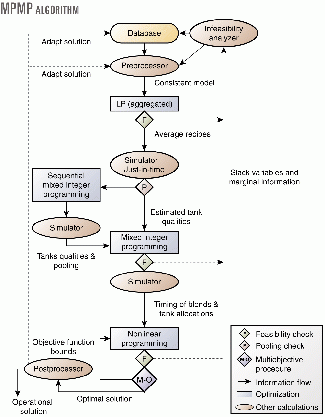07 Jan 2001
Refinery reaps benefits of new decision support system

The introduction of decision support system software for advanced blend scheduling in the SAPREF refinery in Durban, South Africa, resulted in significant financial gains.
Economic analysis at South African Petroleum Refineries (Pty) Ltd's (SAPREF) refinery, a Royal Dutch/Shell and BP joint venture in Durban, South Africa, revealed savings of $1.5 million in one year directly attributable to the use of an advanced blend-scheduling decision-support tool called MPMP.
MPMP, which stands for Multi-Period, Multi-Product and was developed by Shell
The introduction of decision-support software for advanced Global Solutions International, is a computer program that
blend scheduling in the SAPREF refinery in Durban, South Africa, optimizes refinery operations from the point at which
resulted in significant financial gains. rundown streams arrive from the various process units for product blending.

The program considers options for three aspects of the blending process: intermediate pooling in component tanks, blending of the finished grades (both batch-blending and in-line blending), and final storage in product tanks for ultimate delivery from the refinery.
MPMP addresses these aspects of refinery management simultaneously for a range of products and over an extended period of time. Refinery schedulers consequently gain a look-ahead capability, which gives them greater flexibility and allows them to exploit the components they produce to the fullest extent.
Fundamental challenge
Refineries strive to extract the maximum value from their various component streams. Minimizing product quality giveaway is a common goal. Other important goals are preventing excessive stock levels, minimizing oil movements, and avoiding delays to ships lifting their cargoes.
Skilled management of the entire blending and scheduling process, which requires balancing these and other factors, results in improved refinery margins. But it is far from easy. The challenge is particularly difficult when a refinery's production is for export and it must meet many different product specifications during a short time.
Fortunately, the blending and scheduling processes lend themselves to mathematical optimization. Since the introduction of linear programming in the 1950s, increasingly powerful computer programs have become available to help refinery managers.
Blending optimizers, which provide the best recipe for making a particular product, have now reached an advanced state of sophistication. The mathematics, however, become more complex when the issue of the best time to blend a product is introduced and the question of which product to blend is added.
Until recently, commercially available computer programs generally tackled only one half of the problem; either blend-recipe or blend-schedule optimization.
Blend-recipe optimizations have a fixed schedule. That is, the refinery knows which product it needs to produce, when, and in which tank to store it. The program provides the optimum recipe based on the components available at the time.
Blend-schedule optimization, on the other hand, has fixed recipes and projected component stock levels. The computer tool indicates which product to blend and the best time to do it.
It is necessary to resort to mathematical theory to understand why these two elements of the problem are not easily combined. In mathematical terms the first problem involves building a nonlinear model and the second requires building a mixed-integer model. Putting these together results in a mixed-integer, nonlinear programming problem (MINLP), which is extremely difficult to resolve satisfactorily.
Shell's MPMP tool is able to get around this problem, enabling the full picture to be analyzed. MPMP is unusual in addressing the optimum blending of a variety of products (multi-product) during an extended time period (multi-period). It does this using an innovative four-step algorithm, which focuses on individual aspects of the problem in turn.
In the first step, the algorithm aggregates the product requirements over time and finds an approximate solution to the problem. The next stages sequentially refines the solution, first focusing on the issue of pooling the rundown streams from different units, then addressing blend-batch timings and product-tank allocations. Finally, the algorithm establishes batch volumes and optimal recipes.
In essence, the solution algorithm emulates the decision-making process adopted in most refineries: planning, followed by scheduling, then oil movements or operations.
Users' standpoint
Arguably more important than how the program works is what the user sees. An advanced modeling environment called AIMMS (Advanced Integrated Multidimensional Modeling System), developed by Paragon Decision Technology BV, Haarlem, the Netherlands, contains the MPMP core functionality.
As a result, the mathematical complexities are hidden behind a user-friendly, graphical interface. The program runs on a high-end PC with Microsoft Windows.
MPMP comes as a standard but highly flexible software package. During implementation, the system is configured to reflect the exact way an individual refinery works. Any special site requirements can, if necessary, be rendered as subprograms (so called applets) and linked into MPMP via its application programming interface (API).
The versatility of the software is such that it can be easily tied into the overall business decision-making process, helping to address the most fundamental goals of the refinery.
Getting the right data into MPMP in a consistent form is particularly important. Again, on-site implementation includes the development of a dedicated data provision system (DPS) to draw in the required information automatically. Open Database Connectivity (ODBC)-links are available for common databases, such as Oracle and Microsoft Access, and a link to Microsoft Excel is also possible.
The program needs considerable data to provide reliable output. This ranges from the timing of arrival, quantity, and composition of the rundown streams to the required product-lifting pattern-timing of deliveries, quantity, and their specifications. It also has to have the appropriate blending rules and be aware of any recipe restrictions.
Finally, there are various physical and operational constraints that need to be submitted: for example, permitted pipeline flows or routing limitations and maximum and minimum tank capacities.
Not all refineries share the same business and operational targets. For this reason MPMP users can select from a variety of objective functions and apply weightings to them. Economic factors, such as blending margin and cost, and operational issues, such as quality giveaway and the number of oil movements, can be balanced in this way.
Given proper input data, the user can expect MPMP to provide the following kind of information:
- Timing and volume of the blend batches and in-line blends.
- Assignment of blending activities to the available blenders.
- Optimal blend recipes.
- Optimal assignment of blends to and liftings from the product tanks.
- Operational blending instructions formatted in such a way that they can be fed directly into real-time blending control systems.
It is possible that the program finds no feasible solution to the problem the user has set. If so, it indicates this, analyzes the sources of the infeasibility, and suggests ways around it.
Online and off-line use
MPMP can be used in two distinct modes: online to support routine blending operations and off-line for studies and< analysis. Similarly to other Shell refineries using MPMP, the SAPREF refinery used the tool in both these ways.
The refinery used MPMP to provide an optimal blend schedule extending forward for two weeks. The recipes generated were then used to steer an online, real-time blend trimming system, SBPC, supplied by Honeywell. The post-blending data were subsequently returned to MPMP to help update the look-ahead.
Operating in tandem - also referred to as the total blending solution - allows the strengths of each system to be exploited. MPMP first generates a forward operating envelope using its power of economic analysis; then the online optimizer works within this envelope but optimizes each individual blend based on the immediate and more accurate data available at the operations level.
The principal target at SAPREF was to reduce the working capital by bringing down safety stock levels hence operating as close as possible to the operational stock constraints. This was achieved by improving the monthly planning process, using MPMP to challenge the linear programming plan and adjust it to current market conditions. In this way, for example, SAPREF managed to significantly reduce the safety stocks of full-range cat-cracked gasoline. The refinery also met a secondary target to improve operational blending, that is, to reduce quality giveaway. These measures together accounted for about 20% of the MPMP-related saving during the year.
It is worth noting that SAPREF suffered a series of operational upsets during this period, which limited the use of MPMP. The refinery aims to make greater use of the tool online in the future and so expects the savings from this application to rise.
Most of the recorded saving at SAPREF resulted from using MPMP for off-line studies. It was used particularly to help predict the best time for process unit shutdowns and to evaluate trading and business opportunities. In these cases, the output from the system enabled decisions to be made that resulted in quantifiable financial benefits.
MPMP has proven that it can improve refinery margins through its look-ahead capability. It is fully economics-driven and geared to assisting the user to challenge blending margins by operating as closely as possible to the existing constraints. As a result, it provides the user with the ability to influence the broader business picture.
The saving over a year at SAPREF of $1.5 million represents an MPMP payback period of only a few months. The refinery processes an average of 170,000 bbl/d of crude oil. The saving achieved was hence equivalent to 2.4 ¢/bbl. As this savings was recorded during a difficult year for the refinery, the refinery estimates that the saving could
have been closer to 4.0 ¢/bbl
Acknowledgment
Avi Breiner was the driving force behind the development of MPMP and devised the innovative algorithm that forms its basis. Sadly, he recently died following a battle against cancer.
The authors

Avi Breiner was senior planning and scheduling consultant at Shell Global Solutions International, The Hague. He was responsible for the research program in the area of advanced planning and scheduling. Prior to this position, he was responsible for research and development in the areas of advanced decision support and operations research at Shell Research, Amsterdam, the Netherlands. Breiner held a PhD in industrial engineering from the Technion-Israel Institute of Technology, Haifa, Israel.

Rafi Maman is principal engineer of supply chain technologies at Shell Global Solutions International, The Hague. He is responsible for identifying and exploiting new technologies and business opportunities in the area of supply chain management and e-business for the downstream oil industry. He has previously held various international positions with Shell, including R&D engineer, product manager, project manager and senior consultant. Maman holds a BSc in information systems engineering from the Technion-Israel Institute of Technology, Haifa, Israel.